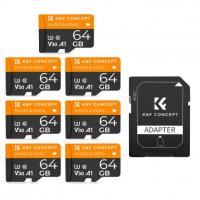How Do I Format An Sd Card?
Formatting an SD card is a common task that many people need to perform for various reasons, such as preparing the card for use in a new device, clearing out old data, or resolving file system errors. This article will guide you through the process of formatting an SD card on different operating systems and devices, ensuring that you can do so safely and effectively.
Understanding the Basics of SD Card Formatting
Before diving into the step-by-step instructions, it's important to understand what formatting an SD card entails. Formatting is the process of preparing a storage device, like an SD card, for use by an operating system. This involves setting up a file system that the operating system can read and write to. Common file systems include FAT32, exFAT, and NTFS.
- FAT32: This is the most widely compatible file system, supported by almost all devices, including cameras, smartphones, and computers. However, it has a file size limit of 4GB.
- exFAT: This file system is designed for flash drives and SD cards. It supports larger files and is compatible with most modern devices.
- NTFS: This is primarily used by Windows systems and supports large files and advanced features like file permissions. However, it is not as widely compatible with non-Windows devices.
Why Format an SD Card?
There are several reasons why you might need to format an SD card:
1. Preparing for Use in a New Device: New devices often require the SD card to be formatted to a specific file system.
2. Clearing Data: Formatting is a quick way to erase all data on the card.
3. Fixing Errors: If the SD card is corrupted or has file system errors, formatting can often resolve these issues.
4. Changing File System: You might need to change the file system to make the SD card compatible with a different device.
Precautions Before Formatting
Before you format an SD card, it's crucial to back up any important data, as formatting will erase all data on the card. Ensure that the SD card is not write-protected, as this will prevent formatting. Also, make sure the card is properly inserted into the device.
Formatting an SD Card on Windows
1. Insert the SD Card: Insert the SD card into your computer's card reader. If your computer doesn't have a built-in card reader, you can use an external USB card reader.
2. Open File Explorer: Press `Win + E` to open File Explorer.
3. Locate the SD Card: In the left-hand pane, find and click on `This PC` or `My Computer`. Your SD card should appear under `Devices and drives`.
4. Right-Click and Select Format: Right-click on the SD card and select `Format` from the context menu.
5. Choose File System: In the Format window, choose the desired file system (FAT32, exFAT, or NTFS). For most purposes, exFAT is a good choice.
6. Quick Format: Check the `Quick Format` box if you want a faster format. Uncheck it for a more thorough format.
7. Start Formatting: Click `Start` to begin the formatting process. A warning will appear, reminding you that all data will be erased. Click `OK` to proceed.
Formatting an SD Card on macOS
1. Insert the SD Card: Insert the SD card into your Mac's card reader.
2. Open Disk Utility: Open `Disk Utility` by going to `Applications > Utilities > Disk Utility`.
3. Select the SD Card: In the left-hand pane, select your SD card.
4. Erase: Click the `Erase` button at the top of the window.
5. Choose Format: In the Erase window, choose the desired file system (usually `ExFAT` or `MS-DOS (FAT)` for FAT32).
6. Name the SD Card: Enter a name for the SD card if desired.
7. Erase: Click `Erase` to begin the formatting process. Confirm any prompts that appear.
Formatting an SD Card on Android
1. Insert the SD Card: Insert the SD card into your Android device.
2. Open Settings: Go to `Settings`.
3. Storage: Tap on `Storage` or `Device care > Storage`.
4. SD Card: Find and select your SD card.
5. Format: Tap on `Format` or `Format SD card`. Confirm any prompts that appear.
Formatting an SD Card on a Camera
1. Insert the SD Card: Insert the SD card into your camera.
2. Menu: Open the camera's menu.
3. Format: Navigate to the `Format` option. This is usually found under `Settings` or `Setup`.
4. Confirm: Select `Format` and confirm any prompts that appear.
Troubleshooting Common Issues
- SD Card Not Recognized: Ensure the card is properly inserted and not damaged. Try using a different card reader or device.
- Write Protection: If the SD card is write-protected, you won't be able to format it. Check for a physical switch on the card and ensure it's in the unlocked position.
- Error Messages: If you encounter error messages during formatting, try using a different file system or a different device to format the card.
Formatting an SD card is a straightforward process that can be done on various devices and operating systems. Whether you're preparing the card for a new device, clearing out old data, or fixing errors, following the steps outlined in this article will help you format your SD card safely and effectively. Always remember to back up important data before formatting, and choose the appropriate file system for your needs. With these guidelines, you'll be able to format your SD card with confidence and ease.










![4K digital camera for photography and video [autofocus and stabilisation] 48 MP video blog camera with SD card, 3 4K digital camera for photography and video [autofocus and stabilisation] 48 MP video blog camera with SD card, 3](https://img.kentfaith.com/cache/catalog/products/us/GW41.0065/GW41.0065-1-200x200.jpg)

























